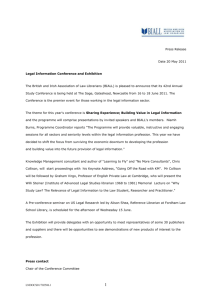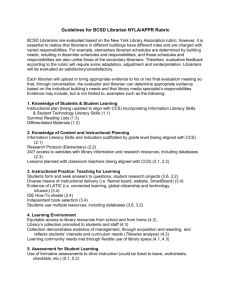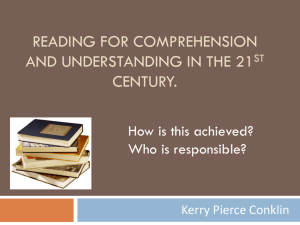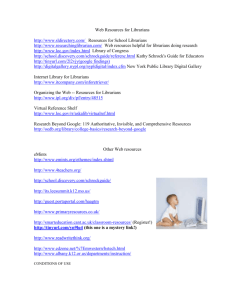Integrating You and the Library into the Curriculum
advertisement
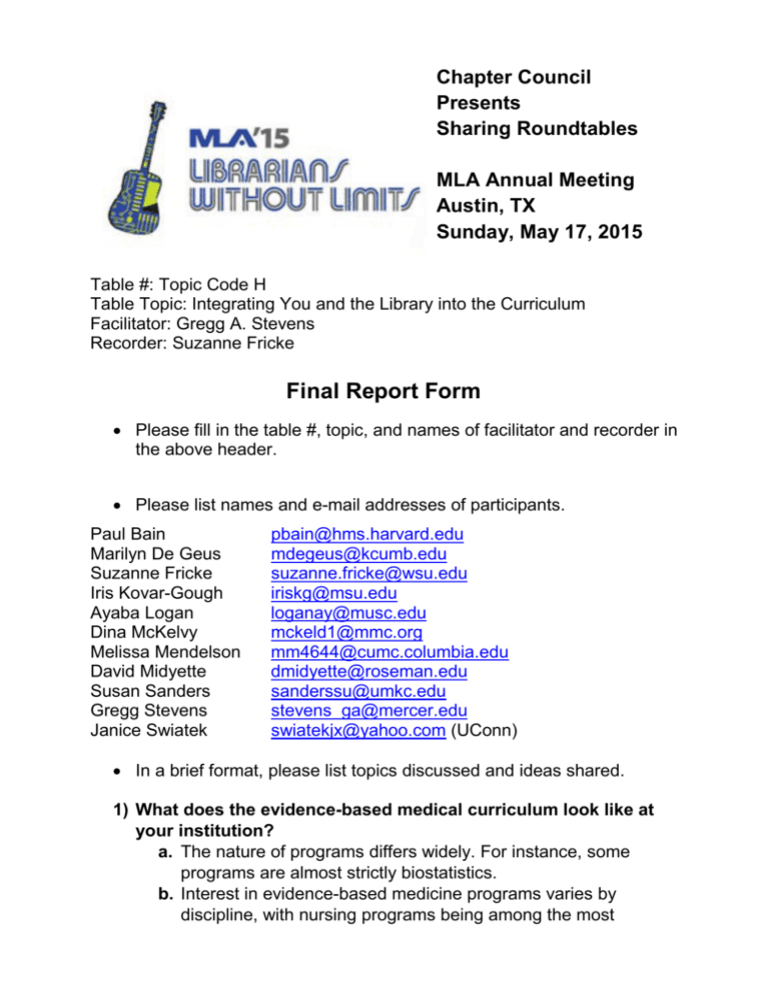
Chapter Council Presents Sharing Roundtables MLA Annual Meeting Austin, TX Sunday, May 17, 2015 Table #: Topic Code H Table Topic: Integrating You and the Library into the Curriculum Facilitator: Gregg A. Stevens Recorder: Suzanne Fricke Final Report Form • Please fill in the table #, topic, and names of facilitator and recorder in the above header. • Please list names and e-mail addresses of participants. Paul Bain Marilyn De Geus Suzanne Fricke Iris Kovar-Gough Ayaba Logan Dina McKelvy Melissa Mendelson David Midyette Susan Sanders Gregg Stevens Janice Swiatek pbain@hms.harvard.edu mdegeus@kcumb.edu suzanne.fricke@wsu.edu iriskg@msu.edu loganay@musc.edu mckeld1@mmc.org mm4644@cumc.columbia.edu dmidyette@roseman.edu sanderssu@umkc.edu stevens_ga@mercer.edu swiatekjx@yahoo.com (UConn) • In a brief format, please list topics discussed and ideas shared. 1) What does the evidence-based medical curriculum look like at your institution? a. The nature of programs differs widely. For instance, some programs are almost strictly biostatistics. b. Interest in evidence-based medicine programs varies by discipline, with nursing programs being among the most receptive. Interest in EBM and embedded librarians in medical programs increases around the time of curriculum review for accreditation which may come every 5-10 years. c. Evidence-based medicine programs are often dependent on a faculty champion, and may disband if that faculty member leaves 2) To what extent are librarians currently embedded in the curriculum? a. Most librarians at the roundtable are not embedded in the curriculum currently, and several mentioned frustration with the minimal amount of time (5-15 minutes) they have for one-shot M1 library orientations. Access to student class lists may be helpful for communication with admitted students prior to their arrival on campus, when they are still excited to learn and have more time to explore resources. b. One roundtable participant is embedded in a one credit asynchronous PhD nursing class thanks to the invitation of a champion of the library who is a department director. This librarian cautioned that programs must meet students at their level. For instance, if students are using Google, instruction needs to start in Google and expand from there. c. Curriculum mapping can identify those classes with research papers, case studies, etc. that may present opportunities for embedding librarians. Go to curriculum meetings and be visible. d. Relevancy and timing of an embedded librarian initiative in relation to current assignments or accreditation visits is important. As cautioned earlier, some programs will be more receptive than others. One librarian voiced frustration with a drug information project among pharmacy students. “You don’t need to be there unless they want you” e. Librarians need to be flexible and able to identify new champions as degree programs evolve (e.g. addition of RN/DNP program). 3) Have librarians tried interprofessional programs? (Dina) What do they look like and how successful have they been? a. Programs can be successful if offered consistently. UMKC had a topically themed interprofessional case study series that was successful (topic example: patient safety in the midst of a medication change) 4) What are your tips for embedded librarians? a. Get faculty permission for embedding in the Learning Management System (LMS) used at your institution (ie. Blackboard (UMKC, WSU), Canvas, Moodle(MUSC), D2L(Roseman)) b. Give Library Guides a title that users might understand better like “research guide,” and make sure that these guides are linked to LMS course pages for assignments. c. Inspire library coworkers to get out of the library and into departments. Sometimes faculty/departments may be more receptive to a new librarian who is able to see things in a different way. d. Job titles can be important. Many institutions use “informationist” or “information specialist” e. Instruction means different things to librarians than it does to medical program faculty. Teaching “information literacy” or even “evidence-based medicine” may be library-centric in focus. Librarians should strive to use the current clinical guidelines, competencies, cases, program accreditation language, and assignments of the medical disciplines they serve. f. Partner with AAHSL resources and ACRL Information Literacy Competencies for Nurses http://www.ala.org/acrl/standards/nursing. 5) Is anyone involved in information architecture? (Iris) Specifically mapping instruction to the curriculum for accreditation purposes. a. Librarians at UMKC assigned keywords and MeSH terms to instruction – though they found some topics were not adequately represented in MeSH terms. b. Harvard previously tagged class material w/ MeSH terms. c. MEDLIB recently had a post by a librarian asking about a way to process large batches of text-filled Excel cells so they could use MeSH on Demand for tagging learning objectives in the curriculum. d. Some schools are using other medical education vocabularies like “MedBiquitous” http://www.medbiq.org/ 6) Do you use a flipped classroom model and how does that impact the library?(Paul) a. A flipped classroom model requires reading, viewing of lectures/tutorials, and self-directed library research by students prior to in-class discussions. This can place a greater burden on librarians to negotiate the question as students may not fully understand their information needs. b. It is essential that librarians have access to the LMS for the flipped classroom model. In Blackboard they may be added to a specific course as faculty, or they can create a channel of content/tutorials that can be made available for all faculty members to add to their courses. c. Schools are using case based primary literature to get students into clinical clerkships by M1(Michigan) and M2(Harvard) d. One criticism of flipped classrooms that students have is that “students are teaching each other.”

